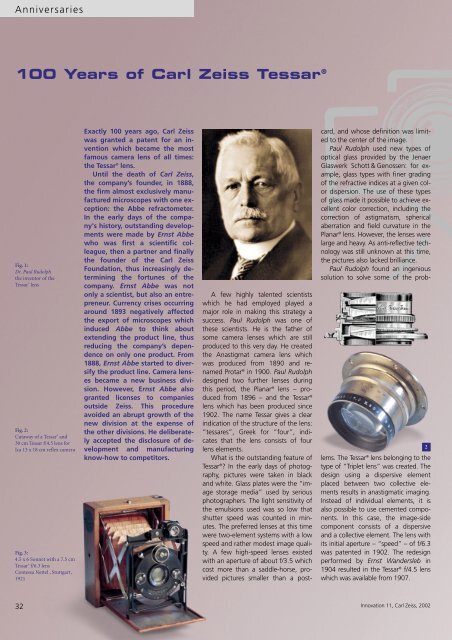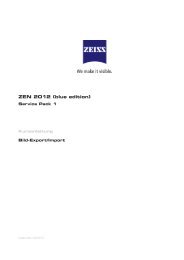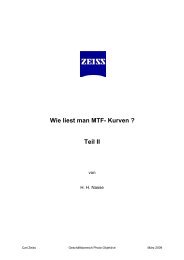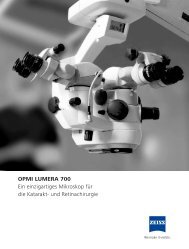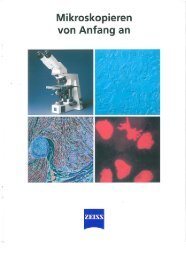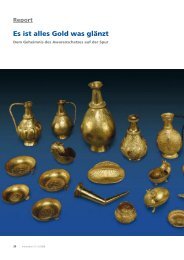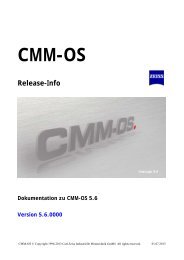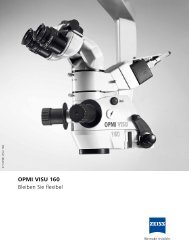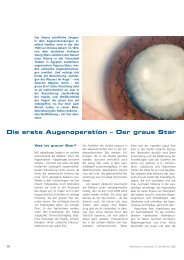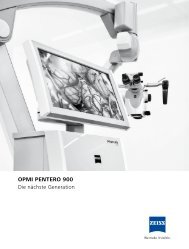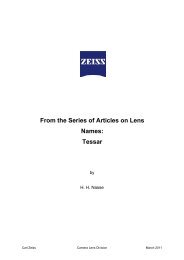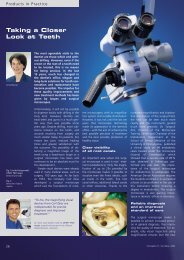100 Years of Carl Zeiss Tessar® - Carl Zeiss, Inc.
100 Years of Carl Zeiss Tessar® - Carl Zeiss, Inc.
100 Years of Carl Zeiss Tessar® - Carl Zeiss, Inc.
Create successful ePaper yourself
Turn your PDF publications into a flip-book with our unique Google optimized e-Paper software.
AnniversariesFig. 1:Dr. Paul Rudolphthe inventor <strong>of</strong> theTessar ® lensFig. 2:Cutaway <strong>of</strong> a Tessar ® and30 cm Tessar f/4.5 lens forIca 13 x 18 cm reflex cameraFig. 3:4.5 x 6 Sonnet with a 7.5 cmTessar ® f/6.3 lensContessa Nettel , Stuttgart,1921<strong>100</strong> <strong>Years</strong> <strong>of</strong> <strong>Carl</strong> <strong>Zeiss</strong> Tessar ® Innovation 11, <strong>Carl</strong> <strong>Zeiss</strong>, 2002Exactly <strong>100</strong> years ago, <strong>Carl</strong> <strong>Zeiss</strong>was granted a patent for an inventionwhich became the mostfamous camera lens <strong>of</strong> all times:the Tessar ® lens.Until the death <strong>of</strong> <strong>Carl</strong> <strong>Zeiss</strong>,the company’s founder, in 1888,the firm almost exclusively manufacturedmicroscopes with one exception:the Abbe refractometer.In the early days <strong>of</strong> the company'shistory, outstanding developmentswere made by Ernst Abbewho was first a scientific colleague,then a partner and finallythe founder <strong>of</strong> the <strong>Carl</strong> <strong>Zeiss</strong>Foundation, thus increasingly determiningthe fortunes <strong>of</strong> thecompany. Ernst Abbe was notonly a scientist, but also an entrepreneur.Currency crises occurringaround 1893 negatively affectedthe export <strong>of</strong> microscopes whichinduced Abbe to think aboutextending the product line, thusreducing the company’s dependenceon only one product. From1888, Ernst Abbe started to diversifythe product line. Camera lensesbecame a new business division.However, Ernst Abbe alsogranted licenses to companiesoutside <strong>Zeiss</strong>. This procedureavoided an abrupt growth <strong>of</strong> thenew division at the expense <strong>of</strong>the other divisions. He deliberatelyaccepted the disclosure <strong>of</strong> developmentand manufacturingknow-how to competitors.A few highly talented scientistswhich he had employed played amajor role in making this strategy asuccess. Paul Rudolph was one <strong>of</strong>these scientists. He is the father <strong>of</strong>some camera lenses which are stillproduced to this very day. He createdthe Anastigmat camera lens whichwas produced from 1890 and renamedProtar ® in 1900. Paul Rudolphdesigned two further lenses duringthis period, the Planar ® lens – producedfrom 1896 – and the Tessar ®lens which has been produced since1902. The name Tessar gives a clearindication <strong>of</strong> the structure <strong>of</strong> the lens:“tessares”, Greek for “four”, indicatesthat the lens consists <strong>of</strong> fourlens elements.What is the outstanding feature <strong>of</strong>Tessar ® ? In the early days <strong>of</strong> photography,pictures were taken in blackand white. Glass plates were the “imagestorage media” used by seriousphotographers. The light sensitivity <strong>of</strong>the emulsions used was so low thatshutter speed was counted in minutes.The preferred lenses at this timewere two-element systems with a lowspeed and rather modest image quality.A few high-speed lenses existedwith an aperture <strong>of</strong> about f/3.5 whichcost more than a saddle-horse, providedpictures smaller than a postcard,and whose definition was limitedto the center <strong>of</strong> the image.Paul Rudolph used new types <strong>of</strong>optical glass provided by the JenaerGlaswerk Schott & Genossen: for example,glass types with finer grading<strong>of</strong> the refractive indices at a given colordispersion. The use <strong>of</strong> these types<strong>of</strong> glass made it possible to achieve excellentcolor correction, including thecorrection <strong>of</strong> astigmatism, sphericalaberration and field curvature in thePlanar ® lens. However, the lenses werelarge and heavy. As anti-reflective technologywas still unknown at this time,the pictures also lacked brilliance.Paul Rudolph found an ingenioussolution to solve some <strong>of</strong> the prob-2lems. The Tessar ® lens belonging to thetype <strong>of</strong> “Triplet lens” was created. Thedesign using a dispersive elementplaced between two collective elementsresults in anastigmatic imaging.Instead <strong>of</strong> individual elements, it isalso possible to use cemented components.In this case, the image-sidecomponent consists <strong>of</strong> a dispersiveand a collective element. The lens withits initial aperture – “speed” – <strong>of</strong> f/6.3was patented in 1902. The redesignperformed by Ernst Wandersleb in1904 resulted in the Tessar ® f/4.5 lenswhich was available from 1907.32
This was soon followed by an f/3.5version for cinematography and projection.In 1908/1909, Ernst Wanderslebdesigned the precursor to theconvertible lens sets <strong>of</strong> the Tessar ®lens with an exchangeable front element.Willy Merté’s development resultedin the Tessar ® f/2.8. lens in1932. A year later, the Tele-Tessar ® Klens (f/6.3/180 mm) with its sensationallyhigh speed was introduced forthe Contax ® camera built from 1932.A “quantum leap“ in the image contrastprovided by optical systems resultedfrom the “anti-reflective coating“ inventedby Alexander Smakula at <strong>Carl</strong> <strong>Zeiss</strong>,a thin, reflection-reducing, vacuumdepositedlayer. A patent applicationfor this procedure was filed in 1935.The Tessar lens was launched on tothe market in many versions. Highqualitystereo lens pairs were part <strong>of</strong>the <strong>Carl</strong> <strong>Zeiss</strong> product spectrum at anearly stage. For example, Paul Frankeand Reinhold Heidecke used preciselypaired 55 mm Tessar f/4.5 lenses in theirfirst Heidoscop stereo camera as earlyas 1920, the year when they foundedtheir company which was later toachieve world renown as “Rollei-Werke Franke & Heidecke”. Worthmentioning is also the 500 mm I.R. –Tessar ® f/5 lens for aerial photographyin the 30 x 30 cm format. An interestingdesign created in 1951, the <strong>Zeiss</strong>-Ikon Panflex ® mirror box, combinedwith the 115 mm Panflex-Tessar ® f/3.5lens launched in 1953, made it possibleto use the Contax ® viewfindercamera like a reflex camera.Standard lenses like the current45 mm Tessar ® T* f/2.8 lens for theContax reflex camera are generallyachromats featuring correction <strong>of</strong>chromatic longitudinal aberration fortwo wavelengths. This also applies tothe Tele-Tessar ® lenses which becameavailable for the 35 mm and the 6 x 6cm formats from 1968. The modernlenses <strong>of</strong> the Tele-Tessar ® T* type forthe Contax ® and Hasselblad Series200 cameras are also achromats. TheTele-Tessar ® HFT lens is available forthe Rolleiflex System 6000. T* andHFT stand for enhanced transmissionthanks to multilayer coating.Higher demands made on colorcorrection are met by apochromaticlenses which are corrected for threewavelengths. As early as 1923, theApo-Tessar ® lens was the most <strong>of</strong>tenused lens in reproduction photography.From 1982, a 500 mm Tele-Apotessar ® f/8 lens was provided forthe Hasselblad 550C camera. Thereare now different versions <strong>of</strong> the Tele-Apotessar ® T* lens for cameras suchas Contax ® , Contax ® 645 Aut<strong>of</strong>ocusfrom Yashica and cameras fromHasselblad and Rollei.The image definition and brillianceprovided by the Tessar ® lens resulted inthe slogan “the eagle eye <strong>of</strong> yourcamera” in 1931. The image-side cementedcomponent was the originalfrom which the “lens logo” was derivedand used for many decades as atrademark <strong>of</strong> the company. To this day,<strong>Carl</strong> <strong>Zeiss</strong> has produced about 5 millionTessar ® lenses for image sizes mea-suring from half a fingernail to thedoor <strong>of</strong> a room. All over the world,lenses are produced which are basedon the Tessar ® design, some licensedby <strong>Carl</strong> <strong>Zeiss</strong>. The result: more than150 million units sold to this day.Dr. Wolfgang Pfeiffer, AalenKornelius Fleischer, Camera Lens Marketingk.fleischer@zeiss.deDr. Dieter Brocksch, Corporate Communications/TechnicalInformationbrocksch@zeiss.deNote:Tessar ® is a registeredtrademarkFig. 4:Contax ® Aria with a 45 mmTessar f/2.8 lens“Star <strong>of</strong> Vision Award”Ahead <strong>of</strong> the biggest ophthalmicexhibition in the USA, the “VisionExpo East Award”, pioneeringachievements in the optical industryare awarded prizes. In 2002, thepanel <strong>of</strong> specialists presented the Star<strong>of</strong> Vision Award to <strong>Carl</strong> <strong>Zeiss</strong>, fora trail-blazing invention made in1935: the anti-reflective coating <strong>of</strong>optical surfaces developed byPr<strong>of</strong>. Alexander Smakula. Since then,the anti-reflective coating has alsoimproved the results obtained withthe Tessar lens as is illustrated by thetwo historic photos taken with andwithout AR coating. It is not unusualfor pioneering inventions to remain inuse for a long time, but it is certainlynot an everyday occurrence for themto be honored with an award manydecades after they have been made.Innovation 11, <strong>Carl</strong> <strong>Zeiss</strong>, 2002 33


